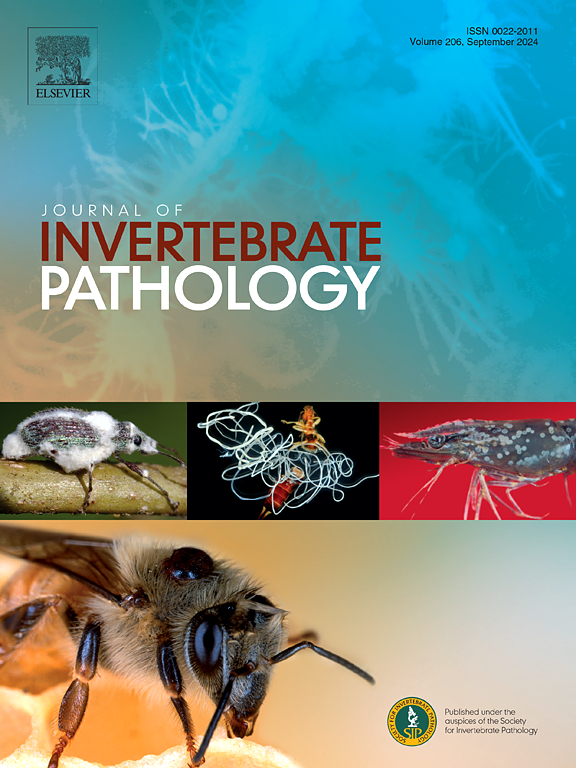Effect of the bacterial pathogen Pseudomonas protegens Pf-5 on the immune response of larvae of the black soldier fly, Hermetia illucens L.
IF 3.6
3区 生物学
Q1 ZOOLOGY
引用次数: 0
Abstract
The larvae of the black soldier fly (BSFL), Hermetia illucens L. (Diptera: Stratiomyidae), are exposed to a diverse range of microorganisms within their feeding substrate that is mainly composed of decaying organic matter. In the current study, we evaluated the effect of an interaction with a Gram-negative bacterium, Pseudomonas protegens Pf-5, on the immune responses of the larvae of H. illucens. Five-day-old BSF larvae were injected with one of five doses of bacterial inoculum to assess survival. We observed dose-dependent mortality in BSF larvae to P. protegens infection, with mortality increasing with an increasing pathogen dose. Injection of more than 50 bacterial cells per larva resulted in 100 % larval mortality, while injection of one bacterial cell per larva caused only 20 % mortality. Phenoloxidase activity, an element of the immune response, correlated with the pathogen dose, increasing early for larvae injected with a high pathogen dose (i.e., 5000 bacterial cells per larva) and later for larvae injected with a low bacterial dose (i.e., one cell per larva). The expression of four genes encoding for antimicrobial peptides (AMPs), namely cecropin, defensin-A, defensin-like peptide 4, and attacin-A, displayed a treatment- and dose-specific expression pattern. Injection with either PBS (control) or different bacterial doses initially induced the upregulation of AMP genes; however, expression reduced over time in the control larvae. At high pathogen dose, all tested genes except hsp70 were consistently induced. The expression of all genes, except hsp70, was induced by low pathogen dose at 2 h, then reduced gradually and increased significantly at 15 h. These results collectively indicate that BSF larvae temporally modulate their immune responses, such as phenoloxidase activation and AMP gene expression, to combat a pathogen within their hemolymph.

病原菌假单胞菌蛋白酶Pf-5对黑兵蝇幼虫免疫应答的影响。
黑兵蝇(BSFL)的幼虫,Hermetia illucens L.(双翅目:层蛾科),在其主要由腐烂的有机物组成的取食基质中暴露于多种微生物。在目前的研究中,我们评估了与革兰氏阴性细菌,假单胞菌蛋白Pf-5相互作用对H. illucens幼虫免疫反应的影响。5日龄的BSF幼虫注射5剂细菌接种物中的1剂以评估存活。我们观察到BSF幼虫对P. protegens感染的死亡率呈剂量依赖性,死亡率随病原体剂量的增加而增加。每只幼虫注射50个以上细菌细胞的死亡率为100% %,而每只幼虫注射1个细菌细胞的死亡率仅为20% %。酚氧化酶活性是免疫反应的一个要素,与病原体剂量相关,在注射高病原体剂量(即每只幼虫5000个细菌细胞)的幼虫中,苯酚氧化酶活性增加得早,而在注射低细菌剂量(即每只幼虫一个细胞)的幼虫中,苯酚氧化酶活性增加得晚。抗菌肽(AMPs)编码基因cecropin、防御素- a、防御素样肽4和攻击素- a的表达呈现出治疗和剂量特异性表达模式。注射PBS(对照)或不同细菌剂量均可诱导AMP基因的上调;然而,对照幼虫的表达随着时间的推移而减少。在高致病菌剂量下,除hsp70外,其余基因均被一致诱导。除hsp70外,其余基因的表达均在2 h低剂量诱导下逐渐降低,在15 h时显著升高。这些结果共同表明,BSF幼虫暂时调节其免疫反应,如酚氧化酶激活和AMP基因表达,以对抗血淋巴内的病原体。
本文章由计算机程序翻译,如有差异,请以英文原文为准。
求助全文
约1分钟内获得全文
求助全文
来源期刊
CiteScore
6.10
自引率
5.90%
发文量
94
审稿时长
1 months
期刊介绍:
The Journal of Invertebrate Pathology presents original research articles and notes on the induction and pathogenesis of diseases of invertebrates, including the suppression of diseases in beneficial species, and the use of diseases in controlling undesirable species. In addition, the journal publishes the results of physiological, morphological, genetic, immunological and ecological studies as related to the etiologic agents of diseases of invertebrates.
The Journal of Invertebrate Pathology is the adopted journal of the Society for Invertebrate Pathology, and is available to SIP members at a special reduced price.

 求助内容:
求助内容: 应助结果提醒方式:
应助结果提醒方式:


